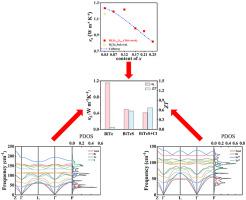Materials Today Physics ( IF 11.5 ) Pub Date : 2021-06-28 , DOI: 10.1016/j.mtphys.2021.100472 Qirui Tao , Fanchen Meng , Zhengkai Zhang , Yu Cao , Yingfei Tang , Jinggeng Zhao , Xianli Su , Ctirad Uher , Xinfeng Tang

|
In this study, a series of Bi2Te2-xS1+x compounds were prepared by traditional melting-quenching-annealing process. In the range of 0.03 ≤ x ≤ 0.25, Bi2Te2-xS1+x compounds possess the Bi2Te3 structure. S atoms preferentially fully occupy the Te(2) sites, while any extra S atoms randomly occupy the Te(1) sites. Experimental results and phonon dispersion calculations demonstrate that the strong coupling of the phonon density of state contributed by Bi and Te(1) atoms results in the low avoided-crossing frequencies, sound velocities, Debye temperature and therefore the low lattice thermal conductivities. Moreover, substitutions of extra S atoms on the Te(1) site intensifies alloy phonon scattering that further suppresses the lattice thermal conductivity. An ultra-low lattice thermal conductivity of 0.49 W m−1 K−1 is achieved at 523 K. Doping with Cl increases the room temperature carrier concentration, resulting in a significantly enhanced power factor from 1.5 mW m−1 K−2 for the Bi2Te1.93S1.07 sample to 1.7 mW m−1 K−2 for the Cl-doped sample at 323 K. Furthermore, doping with Cl enhances phonon point defect scattering that leads to a suppression of the thermal conductivity to 0.41 W m−1 K−1 at 573 K. As a result of the optimization of the electronic transport properties and the reduction in the lattice thermal conductivity, Bi2Te1.93S1.065Cl0.005 sample achieved the highest ZT of 0.67 at 623 K which is superior to intrinsic Bi2Te3 in the whole temperature range.
中文翻译:

Bi 2 Te 2 S 化合物的超低热导率和通过载体工程提高热电性能的起源
本研究采用传统的熔融-淬火-退火工艺制备了一系列Bi 2 Te 2-x S 1+x化合物。在0.03≤x≤0.25的范围内,Bi 2 Te 2-x S 1+x化合物具有Bi 2 Te 3结构。S 原子优先完全占据 Te (2)位点,而任何额外的 S 原子随机占据 Te (1)位点。实验结果和声子色散计算表明 Bi 和 Te 贡献的声子态密度的强耦合(1)原子导致低避免交叉频率、声速、德拜温度,因此导致低晶格热导率。此外,Te (1)位点上额外的 S 原子的取代加强了合金声子散射,进一步抑制了晶格热导率。在 523 K 下实现了 0.49 W m -1 K -1的超低晶格热导率。 掺杂 Cl 增加了室温载流子浓度,导致功率因数从 1.5 mW m -1 K -2显着提高,用于比2特1 .93 S 1.07样品至 1.7 mW m -1 K -2对于 323 K 下的 Cl 掺杂样品。此外,掺杂 Cl 增强了声子点缺陷散射,导致热导率在 573 K下被抑制到 0.41 W m -1 K -1。作为优化的结果电子传输特性和晶格热导率的降低,Bi 2 Te 1 。93秒1 . 065 Cl 0.005样品在 623 K 下达到了0.67的最高ZT,在整个温度范围内均优于本征 Bi 2 Te 3。



























 京公网安备 11010802027423号
京公网安备 11010802027423号